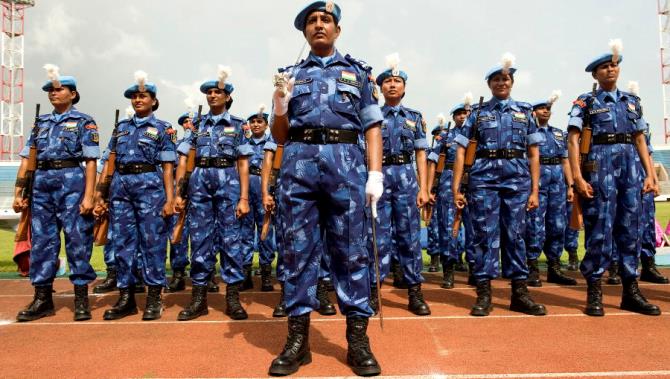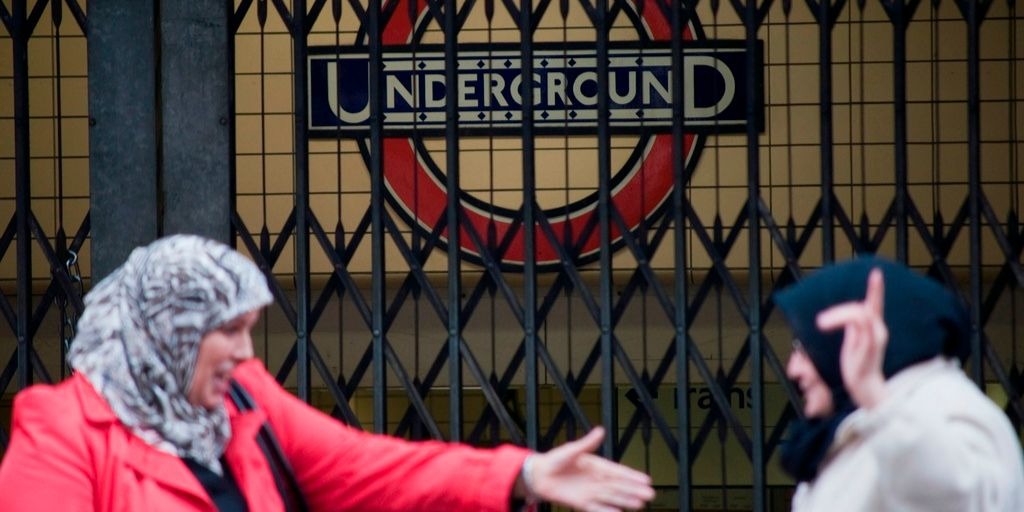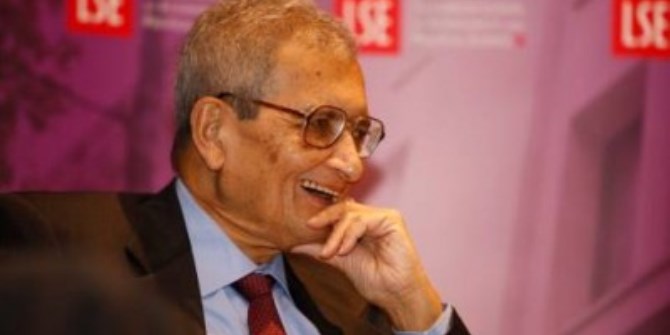
 Women peacekeepers from China and India do pioneering work in South Sudan, Liberia and elsewhere. Yet, a lot remains to be done to truly achieve greater inclusiveness and gender equality in peacekeeping, write Olivia Gippner and Garima Mohan.
Women peacekeepers from China and India do pioneering work in South Sudan, Liberia and elsewhere. Yet, a lot remains to be done to truly achieve greater inclusiveness and gender equality in peacekeeping, write Olivia Gippner and Garima Mohan.
According to UN statistics there are 4,146 women currently deployed in various peacekeeping missions around the globe, who account for 3.8 cent of the total force. In 2000 the landmark UN Security Council Resolution 1325 on women, peace, and security recognised the fact that the experiences of women in armed conflicts differ from those of men and called for increased participation of women in peace efforts. Most intra-state conflicts are characterised by sexual violence and the use of rape as a weapon of war. In addition, accounts of sexual abuse of local women and children by male peacekeepers have been highlighted very often, for instance by the 2004 Report by Refugees International or this April’s allegations of French peacekeepers’ abuse of boys in the Central African Republic. In these situations, the presence of female peacekeepers often becomes vital to ensure post-conflict reconstruction and guarantee security. While the proportion of female peacekeepers has roughly remained the same since the resolution was put in place, since 2012 the numbers have tripled in absolute terms. There are now three all-women formed police units and five women lead peace operations as Special Representatives of the Secretary General.
Overall however, these numbers are still pretty low therefore understanding the experiences of female peacekeepers on the ground becomes important as it sheds light on the shortcomings of the UN system and the improvements that can be made to overcome them. It also highlights that the gender stereotypes of being ‘nurturers and carers’ unwittingly enforced upon these peacekeeping contingents pose an extra burden on the women, already responsible for the onerous task of building and maintaining peace. Changing attitudes towards women peacekeepers and undertaking structural reforms to facilitate greater female participation have the potential to effect real change in international peacekeeping practices.
Given this background, it is elucidating to examine the role and experiences of women peacekeepers from India and China – two major troop contributing countries which have a crucial role in international peacekeeping today. In a pioneering effort, India deployed an ‘all women’ Formed Police Unit in Liberia (UNMIL) in 2007. Similarly, Chinese peacekeeping contingents serving in various parts of Africa have a considerable number of women peacekeepers working in mixed-sex battalions. The first female infantry squad of thirteen peacekeepers was sent to South Sudan in April 2015, marking not only a substantial change for women’s participation, but also symbolising a shift away from established Chinese practice of only sending medical and engineering teams.

Looking closely at the impact of India’s Liberia mission, there were several positives that emerged from the deployment of an all women contingent – both for the local context as well as for the peacekeepers themselves. The contingent comprised more than 100 female peacekeepers whose close involvement in the local community saw them going beyond the mandated tasks by providing self- defense classes for women and conducting regular anti-crime joint night patrols with the Liberian National Police. Annie Abraham, who was the commander of the Indian Unit in 2010, stated that male peacekeepers were actually more intimidating for local women because men were perceived to be the main perpetrators of crimes during the civil war, especially against women and children. In an interview she linked the presence of female troops patrolling the streets with increasing confidence of the local women. According to the New York Times, the Indian unit is further credited by the local policy academy for encouraging increased reporting of sexual abuse, and inspiring an increase in the recruitment of Liberian women for the national police.
Similar patterns are intended for the Chinese female squad. The squad leader Wang Pei emphasised that besides fulfilling the same roles as male peacekeepers, “women soldiers are also responsible for protecting and communicating with women and children in the areas affected.” While little is known about the impact of Chinese female peacekeepers, stories on the women’s good training, their sacrifice and dedication feature high on Chinese national media. Interestingly, interviews with the Indian peacekeepers indicated an impact on the lives of these women as well. For many of them it was the first foray outside their country, or even their home states. The women mentioned that due to their long absence from home, traditional gender roles were reversed as they were no longer expected to combine work with household work.
While their inclusion in troop contingents is a positive step in the right direction, inclusion of women in higher decision-making positions will be crucial if the face of peacekeeping is to truly change towards greater inclusiveness and gender equality. Furthermore the missions need to undergo several structural changes to create a conducive environment not only for those suffering from conflict but also women peacekeepers. An officer from the Indian unit in Liberia interviewed for this piece stated, “though the financial benefits were a consideration in participating in UN missions, the structure is not conducive to greater female participation, it is still an overwhelmingly male space”, pointing specifically to problems like the lack of medical facilities for women peacekeepers in UN camps. She mentioned that the Indian contingent, specifically the Central Reserved Police Forces, deployed women often from low income background who could not afford child care facilities for their children back home. This posed a double burden on these women peacekeepers.
Considering the small numbers of women peacekeepers one might ask, do they lead to a gendered approach to peacekeeping in the countries back home? The picture is complex: Media reports in India either fit a “maternalist narrative”, viewing female peacekeepers as “nurturers”, transplanting a feminine role to peacekeeping operations, or portray the women as “tough”, confident role models. Yet, the spectacular success of the Liberia mission has not led to an increase in recruitment of women in the armed forces in the country. Furthermore, in China the depiction of women peacekeepers mainly relates to their duties back home and idealises the sacrifices they make to participate in the peacekeeping missions. Somewhat paradoxically, at the same time most reports emphasise how men and women have to fulfill equal standards of dedication and fitness.
While the role of women in the Liberia mission has been largely deemed successful by the UN, this success has not been emulated on a larger level: “all women” contingents are still a rarity among peacekeepers. In addition, female peacekeepers are still not included as military commanders and higher decision-making positions. Women in armed forces constitute a minority and structural barriers such as lack of leadership roles and active combat positions, little scope for promotion, absence of maternity benefits and adequate provisions for post-natal care deter them from participating in international peacekeeping in greater numbers. According to a Chinese proverb “women hold up half the sky”; in peacekeeping it still seems like a far-fetched goal.
Note: This article gives the views of the author, and not the position of the India at LSE blog, nor of the London School of Economics. Please read our comments policy before posting.
About the Authors
 Dr. Olivia Gippner is the Dahrendorf Post-Doctoral fellow on EU-East Asia relations at LSE IDEAS. She holds a PhD in political science from Freie Universität Berlin and the Berlin Graduate School of Transnational Studies for which she researched EU-China relations in UN peacekeeping and climate policy-making. She tweets @oliviagipp.
Dr. Olivia Gippner is the Dahrendorf Post-Doctoral fellow on EU-East Asia relations at LSE IDEAS. She holds a PhD in political science from Freie Universität Berlin and the Berlin Graduate School of Transnational Studies for which she researched EU-China relations in UN peacekeeping and climate policy-making. She tweets @oliviagipp.
 Dr. Garima Mohan is a Research Associate with the Global Public Policy Institute (GPPi) in Berlin where she works as an expert on peace and security and rising powers. She holds a PhD in Political Science from the Freie Universität Berlin and the Berlin Graduate School for Transnational Studies. She tweets @GarimaMo.
Dr. Garima Mohan is a Research Associate with the Global Public Policy Institute (GPPi) in Berlin where she works as an expert on peace and security and rising powers. She holds a PhD in Political Science from the Freie Universität Berlin and the Berlin Graduate School for Transnational Studies. She tweets @GarimaMo.







